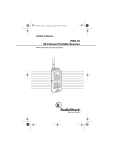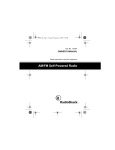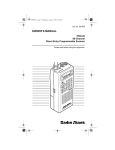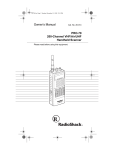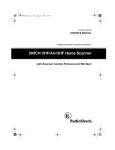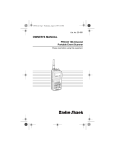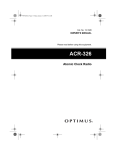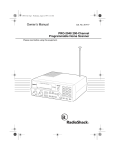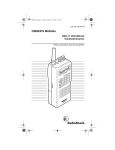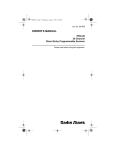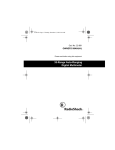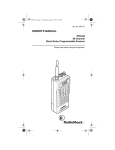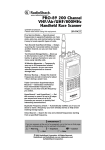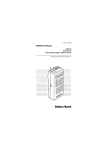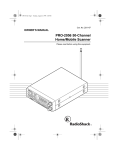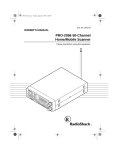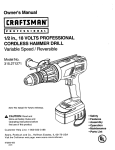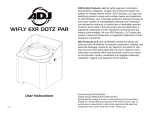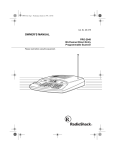Download Radio Shack 200CH Owner`s manual
Transcript
20-313.fm Page 1 Friday, January 7, 2000 3:09 PM Owner’s Manual Cat. No. 20-313 PRO-76 200-Channel VHF/UHF/Air Handheld Scanner Please read before using this equipment. 20-313.fm Page 2 Friday, January 7, 2000 3:09 PM FEATURES Your new RadioShack VHF/ UHF/Air Handheld Scanner lets you in on all the action! This scanner gives you direct access to over 23,000 exciting frequencies, including those used by police and fire departments, ambulance services, aircraft, transportation services, and amateur radio. You can select up to 200 channels for your scanner to scan and you can change your selection at any time. Your scanner also has these special features: Weather Alert — the scanner automatically sounds an alert when it receives a weather emergency signal. Weather Band Key — scans seven preprogrammed weather frequencies to keep you informed about current weather conditions. Wired Programming — you can connect your scanner to a personal computer and program frequencies into the scanner from the computer using an optional cable and software. Note: The necessary cable and software, and additional information about using your personal computer to program your scanner, are available at your local RadioShack store. Liquid Crystal Display — makes it easy to view and change programming information. Search Skip — lets you select up to 20 frequencies for the scanner to skip during a limit or direct search to avoid unwanted frequencies. Direct Search — lets you search for a transmission starting from a specified frequency. Ten Channel-Storage Banks — you can store 20 channels in each bank (200 total channels), letting you group channels so you can more easily identify calls. © 1999 Tandy Corporation. All Rights Reserved. RadioShack and Adaptaplug are registered trademarks used by Tandy Corporation. 2 20-313.fm Page 3 Friday, January 7, 2000 3:09 PM Ten Monitor Memories — let you temporarily save up to ten frequencies you locate during a search, so you can move selected frequencies to channel storage later. Scan Delay — delays scanning for about 2 seconds before moving to another channel, so you can hear more replies that are transmitted on the same channel. You can also set the scanner to delay on all active frequencies during a search. Memory Backup — keeps the channel frequencies stored in memory for an extended time even if the scanner loses power. Three Power Options — you can power the scanner from internal (rechargeable or non-rechargeable) batteries or external AC or DC power (using an optional AC or DC adapter). Low Battery Alert — warns you when the battery power gets low. ing the scanner’s programming. Key Confirmation Tones — the scanner sounds a confirmation tone when you perform an operation correctly and an error tone if you make an error. Lockout Function — lets you set the scanner to ignore specified channels when scanning. Ten Priority Channels — let you set the scanner to check up to ten channels every 2 seconds so you do not miss important calls. Display Backlight — makes the scanner easy to read in low-light situations. Supplied Flexible Antenna with BNC Connector — provides good reception of strong local signals. You can connect an external antenna with a BNC connector to the scanner for improved reception of distant/weaker signals. Key Lock — lets you lock the scanner’s keys to help prevent accidentally chang3 20-313.fm Page 4 Friday, January 7, 2000 3:09 PM Your scanner can receive these bands: Frequency Range (MHz) Types of Transmissions 29–54 10-Meter Ham Band, VHF Lo, 6-Meter Ham Band 108–136.975 Aircraft 137–174 Military Land Mobile, 2-Meter Ham Band, VHF Hi 406–512 Federal Government, 70-cm Ham Band, UHF Standard Band, UHF “T” Band Note: See “Specifications” on Page 44 for more information about the scanner’s frequency steps. 4 20-313.fm Page 5 Friday, January 7, 2000 3:09 PM FCC NOTICE Your scanner might cause radio or TV interference even when it is operating properly. To determine whether your scanner is causing the interference, turn off your scanner. If the interference goes away, your scanner is causing it. Try the following methods to eliminate the interference: • Move your scanner away from the receiver. • Connect your scanner to an outlet that is on a different electrical circuit from the receiver. • Contact your local RadioShack store for help. Note: Mobile use of this scanner is unlawful or requires a permit in some areas. Check the laws in your area. SCANNING LEGALLY Your scanner covers frequencies used by many different groups including police and fire departments, ambulance services, government agencies, private companies, amateur radio services, military operations, pager services, and wireline (telephone and telegraph) service providers. It is legal to listen to almost every transmission your scanner can receive. However, there are some transmissions you should never intentionally listen to. These include: • telephone conversations (cellular, cordless, or other private means of telephone signal transmission) • pager transmissions • any scrambled or encrypted transmissions According to the Electronic Communications Privacy Act (ECPA), you are subject to fines and possible imprisonment for intentionally listening to, using, or divulging the 5 20-313.fm Page 6 Friday, January 7, 2000 3:09 PM contents of such a transmission unless you have the consent of a party to the communication (unless such activity is otherwise illegal). This scanner is designed to prevent reception of illegal transmissions, in compliance with the law which requires that scanners be manufactured in such a way as to not be easily modifiable to pick up those transmissions. Do not open your scanner's case to make any modifications that could allow it to pick up transmissions that it is not legal to listen to. Doing so could subject you to legal penalties. We encourage responsible, legal scanner use. 6 20-313.fm Page 7 Friday, January 7, 2000 3:09 PM CONTENTS Preparation ............................................................................. 9 Installing Batteries ............................................................. 9 Important Information About the External Power Jacks .. 10 Using AC Power .............................................................. 11 Using Vehicle Battery Power ........................................... 12 Charging Rechargeable Batteries ................................... 12 Connecting an Antenna ................................................... 13 Connecting the Supplied Antenna ............................... 13 Connecting an Outdoor Antenna ................................. 14 Connecting an Earphone/Headphones ........................... 15 Listening Safely ........................................................... 15 Traffic Safety ............................................................... 16 Connecting an Extension Speaker .................................. 16 Using the Belt Clip ........................................................... 16 Understanding Your Scanner ............................................. A Look at the Keypad ...................................................... A Look at the Display ...................................................... Understanding Banks ...................................................... Channel Storage Banks .............................................. Monitor Memories ........................................................... 17 17 19 21 21 21 Operation .............................................................................. Turning On the Scanner/Setting Volume and Squelch .... Storing Known Frequencies into Channels ..................... Finding and Storing Active Frequencies .......................... Using Limit Search ...................................................... Using Direct Search .................................................... Using Monitor Memory .................................................... Listening to a Monitor Memory .................................... Moving a Frequency from a Monitor Memory to a Channel ................................................................ Scanning Channels ......................................................... Manually Selecting a Channel ......................................... 22 22 22 23 23 24 25 25 26 26 27 7 20-313.fm Page 8 Friday, January 7, 2000 3:09 PM Special Features .................................................................. Using the Keylock ........................................................... Locking Out Channels .................................................... Delay ............................................................................... Turning Channel-Storage Banks On and Off .................. Using Search Skip Memory ............................................ Using Priority .................................................................. Using the Display Backlight ............................................ Turning the Key Tone On or Off ...................................... Listening to the Weather Band ....................................... WX Alert ...................................................................... Avoiding Image Frequencies ........................................... Resetting the Scanner .................................................... 28 28 28 29 29 30 30 31 32 32 32 33 33 A General Guide to Scanning ............................................ Guide to Frequencies ...................................................... Ham Radio Frequencies ............................................. National Weather Frequencies ................................... Birdie Frequencies ...................................................... Guide to the Action Bands .............................................. Typical Band Usage (MHz) ......................................... Primary Usage ............................................................ Band Allocation ............................................................... Frequency Conversion .................................................... 34 34 34 34 34 35 35 35 36 40 Troubleshooting .................................................................. 41 Care and Maintenance ........................................................ 43 Specifications ...................................................................... 44 8 20-313.fm Page 9 Friday, January 7, 2000 3:09 PM PREPARATION INSTALLING BATTERIES You can power your scanner with four AA batteries (not supplied). For the best performance and longest life, we recommend RadioShack alkaline batteries. Or, you can use rechargeable nickelcadmium or nickel-metal hydride batteries. Both types of batteries are available at your local RadioShack store. of batteries (standard, alkaline, or rechargeable), or rechargeable batteries of different capacities. Follow these steps to install batteries. 1. While pressing down on the tab on the bottom of the battery compartment cover, pull it away from the scanner to remove it. Cautions: • The scanner has a builtin circuit that lets you recharge nickelcadmium batteries inside the battery compartment. However, you must never use this circuit when you have installed nonrechargeable batteries in the scanner. Be sure to read “Important Information About the External Power Jacks” on Page 10 and “Charging Rechargeable Batteries” on Page 12. 2. Install two batteries in the battery compartment and two in the cover as indicated by the polarity symbols (+ and –) marked on the inside of the battery compartment and inside the cover. • Use only fresh batteries of the required size and recommended type. • Do not mix old and new batteries, different types 9 20-313.fm Page 10 Friday, January 7, 2000 3:09 PM IMPORTANT INFORMATION ABOUT THE EXTERNAL POWER JACKS 3. Replace the cover. When BATT.Lo flashes and the scanner beeps every 15 seconds, or if the scanner stops operating properly, replace or recharge the batteries. Warning: Dispose of old batteries promptly and properly. Do not burn or bury them. Caution: If you do not plan to use the scanner with batteries for a month or more, remove the batteries. Batteries can leak chemicals that can destroy electronic parts. The scanner has two external power jacks — POWER and CHARGE. It is important that you understand the purpose of each jack before you connect any adapter to the scanner. The POWER jack lets you power the scanner using an external power source (AC or DC adapter). Connecting an adapter also disconnects the internal batteries. The CHARGE jack supplies power to operate the scanner and also charges the internal batteries. Use the CHARGE jack only when you have installed rechargeable nickel-cadmium batteries. 10 20-313.fm Page 11 Friday, January 7, 2000 3:09 PM Warning: Never use the CHARGE jack when you have installed non-rechargeable batteries. If you try to recharge non-rechargeable batteries, they become very hot and could explode. Remove the plastic plug from the CHARGE jack before you use it, then replace the plug when you finish. POWER CHARGE USING AC POWER You can power the scanner using a 9V, 300-mA AC adapter and a size H Adaptaplug® adapter (neither supplied). Both are available at your local RadioShack store. Cautions: You must use a Class 2 power source that supplies 9V DC and delivers at least 300 mA. Its center tip must be set to positive and its plug must fit the scanner's POWER jack. Using an adapter that does not meet these specifications could damage the scanner or the adapter. ! • Always connect the AC adapter to the scanner before you connect it to AC power. When you finish, disconnect the adapter from AC power before you disconnect it from the scanner. To power the scanner using an AC adapter, attach the Adaptaplug adapter to the AC adapter so the tip reads positive (+), then insert the Adaptaplug adapter into the POWER scanner’s jack. Then connect the other end of the adapter to a standard AC outlet. 11 20-313.fm Page 12 Friday, January 7, 2000 3:09 PM USING VEHICLE BATTERY POWER You can power the scanner from a vehicle’s 12V power source (such as cigarettelighter socket) using a 9V, 300-mA DC adapter and a size H Adaptaplug adapter (neither supplied). Both are available at your local RadioShack store. Cautions: You must use a power source that supplies regulated 9V DC and delivers at least 300 mA. Its center tip must be set to positive and its plug must fit the scanner's POWER jack. Using an adapter that does not meet these specifications could damage the scanner or the adapter. ! • Always connect the DC adapter to the scanner before you connect it to the power source. When you finish, disconnect the adapter from the power source before you disconnect it from the scanner. 12 To power the scanner using a DC adapter, attach the Adaptaplug adapter to the DC adapter so the tip reads positive (+). Set the adapter’s voltage switch to 9V and insert the Adaptaplug adapter into the scanner’s POWER jack, then plug the DC adapter into your vehicle’s cigarette lighter socket. Note: If you use a cigarette lighter power cable and your vehicle’s engine is running, you might hear electrical noise from the engine while scanning. This is normal. CHARGING RECHARGEABLE BATTERIES Your scanner has a built-in charging circuit that lets you charge Ni-Cd rechargeable batteries while they are in the scanner. Important: The scanner’s built-in charging circuit takes a lo ng tim e to re ch arg e nickel-metal hydride batteries while they are installed in the scanner. You must use an external battery charger to charge them. 20-313.fm Page 13 Friday, January 7, 2000 3:09 PM Warning: Do not connect an adapter to the scanner’s CHARGE jack if you installed non-rechargeable batteries (standard, extra-life, or alkaline). Non-rechargeable batteries become hot and could explode if you try to recharge them. It takes between 14 and 16 hours to recharge Ni-Cd rechargeable batteries that are fully discharged. You can operate the scanner while recharging the batteries, but charging takes longer. Note: Ni-Cd batteries last longer and deliver more power if you occasionally let them fully discharge. To do this, simply use the scanner until BATT.Lo flashes and the scanner beeps every 15 seconds. Then fully charge the batteries. 22 Important: This scanner can use NiCd recharge80 0-8 4 3-74 able batteries. At the end of a Ni-Cd battery's useful life, it must be recycled or disposed of properly. Contact your local, county, or state hazardous waste management authorities for information on recycling or disposal programs in your area or call 1-800-843-7422. Some options that might be available are: municipal curbside collection, drop-off boxes at retailers such as your local RadioShack store, recycling collection centers, and mail-back programs. 1- To charge Ni-Cd batteries, remove the plug from the scanner’s CHARGE jack and connect an AC adapter to the jack. CONNECTING AN ANTENNA Connecting the Supplied Antenna You must install an antenna before you can operate the scanner. The supplied flexible antenna helps your scanner receive strong local signals. Follow these steps to install the antenna. 13 20-313.fm Page 14 Friday, January 7, 2000 3:09 PM When deciding on a mobile or base-station antenna and its location, consider these points: • The antenna should be as high as possible on the vehicle or building. 1. Align the slots around the antenna’s connector with the tabs on the antenna jack. 2. Press the antenna down over the jack and turn the antenna’s base clockwise until it locks into place. The scanner’s sensitivity depends on the antenna’s length and various environmental conditions. Connecting an Outdoor Antenna Instead of the supplied antenna, you can connect an outdoor base-station or mobile antenna (not supplied) to your scanner using a BNC connector. Your local RadioShack store sells a variety of antennas. Choose the one that best meets your needs. 14 • The antenna and its cable should be as far as possible from sources of electrical noise, such as appliances or other radios. • The antenna should be vertical for the best performance. Always use 50 Ohm coaxial cable, such as RG-58 or RG-8, to connect the basestation or mobile antenna. For lengths over 50 feet, use RG-8 low-loss dielectric coaxial cable. If the antenna cable’s connector does not fit in the scanner’s antenna jack, you might also need an antenna plug adapter. Your local RadioShack store carries a wide variety of coaxial antenna cable and connectors. Once you choose an antenna, follow the mounting instructions supplied with the antenna, after removing the 20-313.fm Page 15 Friday, January 7, 2000 3:09 PM supplied antenna. Then route the antenna’s cable to the scanner and connect the cable to the scanner’s antenna jack. Cautions: • Do not run the cable over sharp edges or moving parts that might damage it. • Do not run the cable next to power cables or other antenna cables. Warning: Use extreme caution when you install or remove an outdoor antenna. If the antenna starts to fall, let it go! It could contact overhead power lines. If the antenna touches a power line, contact with the antenna, mast, cable, or guy wires can cause electrocution and death. Call the power company to remove the antenna. DO NOT attempt to do so yourself. CONNECTING AN EARPHONE/ HEADPHONES For private listening, you can connect an earphone or headphones with a 1/8-inch (3.5-mm) plug to the jack on top of the scanner. (Your local RadioShack store carries a wide selection of earphones and headphones). Connecting an earphone or headphones automatically disconnects the internal speaker. Listening Safely To protect your hearing, follow these guidelines when you use an earphone or headphones. • Set the volume to the lowest setting before you begin listening. After you begin listening, adjust the volume to a comfortable level. • Do not listen at extremely high volume 15 20-313.fm Page 16 Friday, January 7, 2000 3:09 PM levels. Extended highvolume listening can lead to permanent hearing loss. • Once you set the volume, do not increase it. Over time, your ears adapt to the volume level, so a volume level that does not cause discomfort might still damage your hearing. Traffic Safety • Do not use an earphone/ headphones with your scanner when operating a motor vehicle or riding a bicycle in or near traffic. Doing so can create a traffic hazard and could be illegal in some areas. • If you use an earphone/ headphones with your scanner while riding a bicycle, be very careful. Do not listen to a continuous broadcast. Even though some earphones/headphones let you hear some outside sounds when listening at normal volume levels, they still can present a traffic hazard. 16 CONNECTING AN EXTENSION SPEAKER In a noisy area, an amplified extension speaker (available at your local RadioShack store) positioned in the right place might provide more comfortable listening. Plug the speaker cable’s 1/8inch (3.5-mm) plug into your scanner’s jack. Note: Connecting an external speaker disconnects the scanner’s internal speaker. USING THE BELT CLIP You can attach the supplied belt clip to make the scanner easier to use when you are on the go. Use a Phillips screwdriver and the two supplied screws to attach the belt clip to the scanner. 20-313.fm Page 17 Friday, January 7, 2000 3:09 PM UNDERSTANDING YOUR SCANNER Once you understand a few simple terms we use in this manual and familiarize yourself with your scanner’s features, you can put the scanner to work for you. You simply determine the type of communications you want to receive, then set the scanner to scan them. A frequency is the tuning location of a station (expressed in kHz or MHz). To find active frequencies, you can use the search function. When you find a frequency, you can store it into a programmable memory location called a channel, which is grouped with your other channels in a channel-storage bank. You can then scan the channel-storage banks to see if there is activity on the frequencies stored there. Each time the scanner finds an active frequency, it stays on that channel until the transmission ends. A LOOK AT THE KEYPAD Your scanner’s keys might seem confusing at first, but this information should help you understand each key’s function. 17 20-313.fm Page 18 Friday, January 7, 2000 3:09 PM Note: Some of the scanner’s keys perform more than one function and are marked with more than one label. The steps in this Owner’s Manual show only the label appropriate to the action being performed. SCAN Scans programmed channels. MANUAL Stops scanning and lets you directly enter a channel number. S/S-L/OUT Skips a specified frequency during limit or direct search; lets you lock out selected channels. PRI Turns the priority feature on and off. MON Accesses one of the ten monitor memories. DELAY Programs a 2-second delay for the selected channel; sets a delay for all active frequencies during a search. ALERT Turns the weather alert feature on or off. HOLD Holds the frequency search. CLEAR/• Clears an incorrect entry; enters a decimal point. WX/E (Enter) Scans the seven preprogrammed weather channels; enters frequencies into channels. KEYLOCK/ Locks/unlocks the keypad to prevent accidental entries; turns on the display light for about 15 seconds. PROG Programs frequencies into channels. ▼/LIMIT/▲ Searches up or down for active frequencies; programs the limit search frequency range. 18 20-313.fm Page 19 Friday, January 7, 2000 3:09 PM Number Keys Enters a single-digit (0 to 9) or a range of numbers. Use the range of numbers above the key (21–40 for example) when selecting the number for a desired channel-storage bank. See “Understanding Banks” on Page 21. Use the single digits to enter a channel or frequency. A LOOK AT THE DISPLAY The display has indicators that show the scanner’s current operating status. This quick look at the display will help you understand how your scanner operates. P Appears when you listen to the priority channel. ▼ /▲ Indicates the search direction. ALT Appears when weather alert mode is active. ALT flashes when the scanner detects the weather alert signal. BANK Shows which banks are turned on for scanning (see “Understanding Banks” on Page 21). BATT.Lo Appears when the batteries are low. CH Appears with digits (1–200) to show which channel the scanner is tuned to. 19 20-313.fm Page 20 Friday, January 7, 2000 3:09 PM d Appears instead of the channel number during a direct search. DLY Appears when you program a delay. Error Appears when you make an entry error. H Appears during a limit search hold. h Appears during a direct search hold. Hi Appears with a selected frequency to show the search range’s upper limit. KEYLOCK Appears when you lock the keypad. L Appears instead of the channel number during a limit search. Lo Appears with a selected frequency to show the search range’s lower limit. L/O (lockout) Appears when you manually select a channel that was previously locked out or when you manually select a frequency that was previously stored in search skip memory. MON Appears when you listen to a monitor memory. A number (1–10) appears to the right of MON indicating which monitor memory you are listening to. MHz Digits that precede this indicator show which frequency the scanner is tuned to. MAN Appears when you manually select a channel. PGM Appears when you program frequencies into the scanner’s channels. 20 20-313.fm Page 21 Friday, January 7, 2000 3:09 PM PRI Appears when the priority feature is turned on. SCAN Appears when the scanner scans channels. SRCH Appears during limit, direct, and weather band searches. WX Indicates that the scanner is searching the weather channels. UNDERSTANDING BANKS Channel Storage Banks To make it easier to identify and select the channels you want to listen to, channels are divided into 10 banks of 20 channels each. Use each channel-storage bank to group frequencies, such as those used by the police department, fire department, ambulance services, or aircraft (see “Guide to the Action Bands” on Page 35). For example, the police department might use four frequencies, one for each side of town. You could program the police frequencies starting with Channel 1 (the first channel in bank 1) and program the fire department frequencies starting with Channel 21 (the first channel in bank 2). MONITOR MEMORIES The scanner has 10 monitor memories that you can use to temporarily store frequencies while you decide whether to save them into channels. This is handy for quickly storing an active frequency when you are searching through an entire band. You can store a frequency into a monitor memory during a limit or direct search. See “Finding and Storing Active Frequencies” on Page 23. 21 20-313.fm Page 22 Friday, January 7, 2000 3:09 PM OPERATION TURNING ON THE SCANNER/ SETTING VOLUME AND SQUELCH 1. Turn SQUELCH counterclockwise. fully 2. To turn on the scanner, turn VOLUME clockwise until you hear a hissing sound. 3. Turn SQUELCH clockwise, just until the hissing sound stops. Notes: • To listen to a weak or distant station, turn SQUELCH counterclockwise. If reception is poor, turn SQUELCH clockwise to cut out weak transmissions. SQUELCH • If is adjusted so you always hear a hissing sound, the scanner will not scan or search properly. 4. To turn off the scanner when you finish, turn VOLUME counterclockwise to OFF. 22 STORING KNOWN FREQUENCIES INTO CHANNELS Good references for active frequencies are the RadioShack Police Call Guide including Fire and Emergency Services, Official Aeronautical Frequency Directory, and Maritime Frequency Directory. We update these directories every year, so be sure to get a current copy. Follow these steps to store frequencies into channels. 1. Press MANUAL then enter the channel number (1–200) where you want to store a frequency. 2. Press PROG. PGM appears. 3. Use the number keys and • to enter the frequency (including the decimal point) you want to store. 20-313.fm Page 23 Friday, January 7, 2000 3:09 PM 4. Press E to store the frequency into the channel. Notes: • If you made a mistake in Step 3, Error appears and the scanner beeps three times when you press E. Simply start again from Step 3. • Your scanner automatically rounds the entered frequency down to the closest valid frequency. For example, if you enter a frequency of 151.473, your scanner accepts it as 151.475. 5. Repeat Steps 1–4 to program more channels. Or to program the next channel in sequence, repeat Steps 2–4. To listen to a stored frequency, press MANUAL, enter the channel number, then press MANUAL again. FINDING AND STORING ACTIVE FREQUENCIES Using Limit Search A limit search lets you search for active frequencies between upper and lower limits that you set. L appears during a limit search. Follow these steps to enter the search frequency range. 1. Press PROG then LIMIT. Lo appears. 2. Use the number keys and • to enter the lower limit frequency of the range you want to search. 3. Press E then LIMIT. Hi appears. Note: If the frequency you entered is not valid, Error appears. Enter a different frequency then repeat Step 3. 4. Use the number keys and • to enter the upper limit frequency of the range you want to search. 5. Press E. 23 20-313.fm Page 24 Friday, January 7, 2000 3:09 PM 6. Press ▼ to search from the upper to the lower limit or ▲ to search from the lower to the upper limit. The current monitor memory number flashes. 7. When the scanner stops on a transmission you want to save, press MON to store the frequency in the current monitor memory. The monitor memory number stops flashing. 8. Press either ▼ or ▲ to continue the search. If you saved a frequency in a monitor memory, the monitor memory number advances by one and starts flashing again. (If the last monitor memory was 10, the scanner returns to monitor memory 1.) Note: To replace a frequency in a monitor memory, store a new frequency in that monitor memory. 9. To hold the frequency, press HOLD. H appears. To resume the limit search, press HOLD again. 24 Notes: • You can press ▼ or ▲ while H appears to step through the frequencies toward the upper or lower limit. • If you tune to a search skip frequency, L/O appears (see “Using Search Skip Memory” on Page 30). Using Direct Search During a direct search, the scanner searches up or down starting from the displayed frequency. d appears during a direct search. Follow these steps to use direct search. Note: You can use the scanner’s delay feature while using direct search. 1. Press MANUAL then use the number keys and • to enter the starting frequency of the range you want to search. Or, to select a frequency stored in a channel, press MANUAL, use the number keys to enter the channel number, 20-313.fm Page 25 Friday, January 7, 2000 3:09 PM then press again. MANUAL 2. Press ▼ or ▲ to search up or down from the selected frequency. 3. When the scanner stops on a transmission you want to save, press MON to store the frequency in the current monitor memory. The monitor memory number stops flashing. 4. Press either ▼ or ▲ to continue the search. If you saved a frequency in a monitor memory, the monitor memory number advances by one and starts flashing again. (If the last monitor memory was 10, the scanner returns to monitor memory 1.) Notes: • You can press ▼ or ▲ while h appears to step through the frequencies upward or downward. • If you tune to a search skip frequency, L/O appears (see “Using Search Skip Memory” on Page 30). USING MONITOR MEMORY Listening to a Monitor Memory To listen to the monitor memories you stored during a search, press MANUAL, MON, then the number of the memory you want to listen to. Use the 1–9 number keys for memories 1–9, and 0 for memory 10. Or repeatedly press MON to cycle through the stored monitor memories. 25 20-313.fm Page 26 Friday, January 7, 2000 3:09 PM Moving a Frequency from a Monitor Memory to a Channel Follow these steps to move a frequency stored in a monitor memory to a permanent channel. 1. Press MANUAL. appears. MAN 2. Enter the number (1– 200) for the channel where you want to store the monitor frequency. The channel number appears. 3. Press PROG. The currently stored frequency appears. 4. Press MON then the number of the monitor memory number that has the frequency you want to store. The channel number flashes. 5. Press E. The scanner stores the frequency in the selected channel, and the channel number stops flashing. 26 SCANNING CHANNELS Note: You cannot scan channels until you have stored frequencies in them. To scan channels stored in the channel-storage banks, press SCAN. The scanner scans through all channels in the active banks. To select one or more channelstorage banks while scanning, select each bank you want to scan by pressing its number key so the bank’s number appears on the display. To turn off channel-storage banks, press the number key for each of the bank(s) so the bank’s number disappears. The scanner does not scan any of the stored channels within banks you have turned off. To set the scanner to remain on the current channel even after the transmission stops, press MANUAL at any time during the transmission. 20-313.fm Page 27 Friday, January 7, 2000 3:09 PM To lock out channels so the scanner does not stop for a transmission on those channels, see “Locking Out Channels” on Page 28. Notes: • You can manually select any channel in a bank, even if the bank is turned off. • You cannot turn off all ten banks. MANUALLY SELECTING A CHANNEL You can continuously monitor a specific channel without scanning. This is useful if you hear an emergency broadcast on a channel and do not want to miss any details (even though there might be periods of silence) or if you simply want to monitor that channel. Follow these steps to manually select a channel. 1. Press MANUAL. 2. Enter the channel number (1–200). 3. Press MANUAL again. 27 20-313.fm Page 28 Friday, January 7, 2000 3:09 PM SPECIAL FEATURES USING THE KEYLOCK Once you program your scanner, you can protect it from accidental program changes by turning on the keylock feature. When the keypad is locked, the only controls that operate are SCAN, MANUAL, KEYLOCK, VOLUME, and SQUELCH. Note: The keylock does not prevent the scanner from scanning channels. To turn the keylock on or off, turn on the scanner then hold down KEYLOCK for about 3 seconds. The scanner beeps and KEYLOCK appears or disappears. LOCKING OUT CHANNELS You can increase the effective scanning speed by locking out individual channels that have a continuous transmission, such as a weather channel (see “National Weather Frequencies” on Page 34) or a birdie 28 frequency (see “Birdie Frequencies” on Page 34). To lock out a channel, manually select the channel then press L/OUT. L/O appears. To remove the lockout from a channel, manually select the channel then pr ess L/OUT. L/O disappears. To unlock all memory channels, follow these steps. 1. While scanning, turn on the memory banks you want to unlock. 2. Press MANUAL. 3. Hold down L/OUT for at least 3 seconds. The scanner beeps twice and unlocks all memory channels you previously locked out (in the selected banks). Notes: • Your scanner automatically locks out empty channels. • You can still manually select locked-out channels. 20-313.fm Page 29 Friday, January 7, 2000 3:09 PM DELAY Many agencies use a twoway radio system that has a period of several seconds between a query and a reply. To avoid missing a reply, you can program a 2second delay into any channel or frequency. When your scanner stops on a channel or frequency with a programmed delay, DLY appears. The scanner continues to monitor that frequency for 2 seconds after the transmission stops. Then the scanner resumes scanning or searching. You can program a 2-second delay in any of these ways: • If the scanner is scanning and stops on an active channel, quickly press DELAY before it resumes scanning. • If the desired channel is not selected, manually select the channel, then press DELAY. • If the scanner is searching, press DELAY. DLY appears and the scanner automatically adds a 2-second delay to every transmission it stops on during a limit or direct search. To turn off the 2-second delay on a channel or frequency, press DELAY while the scanner is monitoring that channel or frequency. DLY disappears. TURNING CHANNELSTORAGE BANKS ON AND OFF You can turn each channelstorage bank on and off. When you turn off a bank, the scanner does not scan any of the 20 channels in that bank. While scanning, press the number key corresponding to the bank you want to turn on or off. (Press 0 to select bank 10). If the memory bank indicator is on, the bank is turned on and the scanner scans all channels within that bank that are not locked out. If the indicator is off, the scanner does not scan any of the channels within that bank. 29 20-313.fm Page 30 Friday, January 7, 2000 3:09 PM Notes: • You can manually select any channel in a bank, even if the bank is turned off. • You cannot turn off all banks. One bank is always active. (where L/O appears). Then hold down S/S until L/O disappears. To clear all the skip frequencies from search skip memory at once, during a search, hold down S/S until the scanner beeps twice. Notes: USING SEARCH SKIP MEMORY You can skip specified frequencies during a limit or direct search. This lets you avoid unwanted frequencies or ones you have already stored in a channel. You can program up to 20 frequencies to be skipped into the scanner’s memory. To skip a frequency, press S/S when the scanner stops on the frequency during a limit or direct search. L/O (lockout) appears the next time you display that frequency. To clear a single frequency from search skip memory so the scanner can stop on it during a limit or direct search, press HOLD to hold the search. Then press ▼ or ▲ to select the frequency 30 • If you program more than 20 skip frequencies, each new frequency replaces one you stored earlier, starting from the first stored frequency. • You can select a skipped frequency by using ▼ or ▲ when the scanner is holding. L/O appears when you select a skipped frequency. USING PRIORITY You can scan through channels and still not miss important calls on specific channels. You can program one stored channel in each bank as a priority channel (for up to a total of 10 stored channels). As the scanner scans the bank, if the priority feature is turned on, the scanner checks the priority 20-313.fm Page 31 Friday, January 7, 2000 3:09 PM channel for activity every 2 PRI appears seconds. whenever the scanner is set to use priority. The scanner automatically designates each bank’s first channel as its priority channel. Follow these steps to select a different channel as the priority channel for a bank. 1. Press PROG. 2. Enter the channel number you want to select as the priority channel, then press PRI. P appears to the right of the channel number. 3. Repeat Step 2 for the channel in each bank you want to program as a priority channel. To turn on the priority feature, press PRI while MAN or SCAN appear. PRI appears. As you scan the bank, the scanner checks the bank’s priority channel every 2 seconds in each bank that is turned on, starting from the lowest to the highestnumbered priority channel. Notes: • You cannot select a monitor memory when priority is turned on. • You can lock out priority channels. If you lock out all priority channels, P CH LOC Out appears when you turn on the priority feature. USING THE DISPLAY BACKLIGHT You can turn on the display’s backlight for easy viewing in the dark. Press to turn on the display light for 15 seconds. To turn off the light sooner, press again. Note: The scanner locks the keypad (see “Using the KeyLock” on Page 28) if you hold down . If this happens, hold down until the scanner beeps (if the key tone is turned on) and KEYLOCK disappears. To turn off the priority feature, press PRI. PRI disappears. 31 20-313.fm Page 32 Friday, January 7, 2000 3:09 PM TURNING THE KEY TONE ON OR OFF The scanner is preset to sound a tone each time you press any of its keys. Follow these steps to turn the scanner’s key tone on or off. 1. If the scanner is turned on, turn VOLUME counterclockwise until it clicks to turn it off. 2. Hold down S/S while you turn on the scanner. no bEEP (if the key tone is off) or On bEEP (if the key tone is on) appears for about 3 seconds. LISTENING TO THE WEATHER BAND To hear your local forecast and regional weather information, press WX. Your scanner begins to scan through the weather band. Your scanner should stop within a few seconds on your local weather broadcast. If the broadcast is weak, you can press WX again or ▼ or ▲ to resume scanning. 32 WX Alert Your scanner warns you of serious weather conditions by sounding an alarm if a National Weather Service broadcaster in your area broadcasts an alert tone. Follow these steps to set the scanner so it sounds an alarm when a weather alert tone is broadcast. 1. Press WX to scan the weather channels. 2. Press ALERT. ALT appears. If the scanner detects the weather alert, it sounds an alarm and ALT flashes. Press any key to turn off the alarm. To cancel all weather alert checking, press ALERT. 20-313.fm Page 33 Friday, January 7, 2000 3:09 PM AVOIDING IMAGE FREQUENCIES You might discover one of your regular stations on another frequency that is not listed. It might be what is known as an image frequency. For example, you might find a service that regularly uses a frequency of 431.875 also on 474.675. To see if it is an image, do a little math. Note the new frequency 474.675 Double the intermediate frequency of 21.4 MHz (42.800) and subtract it from the new frequency –42.800 If the answer is the regular frequency then you have tuned to an image. 431.875 Occasionally, you might get interference on a weak or distant channel from a strong broadcast 42.8 MHz above or below the tuned frequency. This is rare, and the image signal is usually cleared whenever there is a broadcast on the actual frequency. RESETTING THE SCANNER If the scanner’s display locks up or does not work properly after you connect a power source, you might need to reset the scanner. Caution: This procedure clears all the information you have stored into the scanner. Before you reset the scanner, try turning it off and on to see if it begins working properly. Reset the scanner only when you are sure it is not working properly. To reset the scanner, turn it off then turn it back on while holding the 2 and 9 keys. CLEAr appears. 33 20-313.fm Page 34 Friday, January 7, 2000 3:09 PM A GENERAL GUIDE TO SCANNING Reception of the frequencies covered by your scanner is mainly “line-of-sight.” That means you usually cannot hear stations that are beyond the horizon. GUIDE TO FREQUENCIES Ham Radio Frequencies Ham radio operators often broadcast emergency information when other means of communication break down. The following chart shows the voice frequencies that you can monitor: Wavelength (Meters) 10-Meter 6-Meter 2-Meter 70-Centimeter Voice (MHz) 29.000–29.700 MHz 50.100–54.000 MHz 144.100–148.000 MHz 420.000–450.000 MHz National Weather Frequencies 162.400 162.500 162.425 162.525 162.450 162.550 162.475 Birdie Frequencies Every scanner has birdie frequencies. Birdies are signals created inside the scanner’s receiver. These operating frequencies might interfere with broadcasts on the same frequencies. If you program one of these frequencies, you hear only noise on that frequency. If the interference is not severe, you might be able to turn SQUELCH clockwise to cut out the birdie. This scanner’s birdie frequency (in MHz) is 146.65 MHz. To find the birdies in your individual scanner, begin by disconnecting the antenna and moving it away from the scanner. Make sure that no other nearby radio or TV sets are turned on near 34 20-313.fm Page 35 Friday, January 7, 2000 3:09 PM the scanner. Use the search function and search every frequency range from its lowest frequency to the highest. Occasionally, the scanner will stop searching as if it had found a signal. However, the signal often is silent. That is a birdie. Make a list of all the birdies in your scanner for future reference. GUIDE TO THE ACTION BANDS Typical Band Usage (MHz) VHF Band Low Range 6-Meter Amateur U.S. Government 2-Meter Amateur High Range 29.00–50.00 50.00–54.00 137.00–144.00 144.00–148.00 148.00–174.00 UHF Band U.S. Government 70-Centimeter Amateur Low Range FM-TV Audio Broadcast, Wide Band 406.00–420.00 420.00–450.00 450.00–470.00 470.00–512.00 Primary Usage As a general rule, most of the radio activity is concentrated on the following frequencies: VHF Band Activities 2-Meter Amateur Band Government, Police, and Fire Emergency Services Railroad Frequencies (MHz) 144.000–148.000 153.785–155.980 158.730–159.460 160.000–161.900 35 20-313.fm Page 36 Friday, January 7, 2000 3:09 PM UHF Band Activities 70-Centimeter Amateur Band FM Repeaters Land-Mobile “Paired” Frequencies Base Stations Mobile Units Repeater Units Control Stations Frequencies (MHz) 440.000–450.000 450.000–470.000 451.025–454.950 456.025–459.950 460.025–464.975 465.025–469.975 Note: Remote control stations and mobile units operate at 5 MHz higher than their associated base stations and relay repeater units. BAND ALLOCATION To help decide which frequency ranges to scan, use the following listing of the typical services that use the frequencies your scanner receives. These frequencies are subject to change, and might vary from area to area. For a more complete listing, refer to the Police Call Radio Guide including Fire and Emergency Services, available at your local RadioShack store. Abbreviations Services AIR . . . . . . . . . . . . . . . . . . . . . . . . . . . . . . . . . . . . . . . . . . . . . . Aircraft BIFC . . . . . . . . . . . . . . . . . . . . . . . Boise (ID) Interagency Fire Cache BUS . . . . . . . . . . . . . . . . . . . . . . . . . . . . . . . . . . . . . . . . . . . . Business CAP . . . . . . . . . . . . . . . . . . . . . . . . . . . . . . . . . . . . . . . . Civil Air Patrol CB . . . . . . . . . . . . . . . . . . . . . . . . . . . . . . . . . . . . . . . . . Citizens Band CCA . . . . . . . . . . . . . . . . . . . . . . . . . . . . . . . . . . . . . . Common Carrier CSB . . . . . . . . . . . . . . . . . . . . . . . . . . . . . . . . . Conventional Systems CTSB . . . . . . . . . . . . . . . . . . . . . . . . . Conventional/Trunked Systems FIRE . . . . . . . . . . . . . . . . . . . . . . . . . . . . . . . . . . . . . Fire Department HAM . . . . . . . . . . . . . . . . . . . . . . . . . . . . . . . . . Amateur (Ham) Radio GOVT . . . . . . . . . . . . . . . . . . . . . . . . . . . . . . . . . Federal Government GMR . . . . . . . . . . . . . . . . . . . . . . . . . . . . . . . . . General Mobile Radio GTR . . . . . . . . . . . . . . . . . . . . . . . . . . . . . . . . . . . . . . General Trunked IND . . . . . . . . . . . . . . . . . . . . . . . . . . . . . . . . . . . . . Industrial Services (Manufacturing, Construction, Farming, Forest Products) 36 20-313.fm Page 37 Friday, January 7, 2000 3:09 PM MAR . . . . . . . . . . . . . . . . . . . . . . . . . . . . . . . . . Military Amateur Radio MARI . . . . . . . . . . . . . . . . . . . . . . . . . . . . . . . . Maritime Limited Coast (Coast Guard, Marine Telephone, Shipboard Radio, Private Stations) MARS . . . . . . . . . . . . . . . . . . . . . . . . . Military Affiliate Radio System MED . . . . . . . . . . . . . . . . . . . . . . . . . . . . Emergency/Medical Services MIL . . . . . . . . . . . . . . . . . . . . . . . . . . . . . . . . . . . . . . . . . . U.S. Military MOV . . . . . . . . . . . . . . . . . . . . . . . . . . . . Motion Picture/Video Industry NEW . . . . . . . . . . . . . . . . . . . . . . . . . . . . . . . . . . New Mobile Narrow NEWS . . . . . . . . . . . . . . . . . . . . Relay Press (Newspaper Reporters) OIL . . . . . . . . . . . . . . . . . . . . . . . . . . . . . . . . . . Oil/Petroleum Industry POL . . . . . . . . . . . . . . . . . . . . . . . . . . . . . . . . . . . . Police Department PUB . . . . . . . . . . . . . . . . . . . . . . . . . . . . . . . . . . . . . . . Public Services (Public Safety, Local Government, Forestry Conservation) PSB . . . . . . . . . . . . . . . . . . . . . . . . . . . . . . . . . . . . . . . . . Public Safety PTR . . . . . . . . . . . . . . . . . . . . . . . . . . . . . . . . . . . . . . Private Trunked ROAD . . . . . . . . . . . . . . . . . . . . . . . . . Road & Highway Maintenance RTV . . . . . . . . . . . . . . . . . . . . . . Radio/TV Remote Broadcast Pickup TAXI . . . . . . . . . . . . . . . . . . . . . . . . . . . . . . . . . . . . . . . . Taxi Services TELB . . . . . . . . . . . . . . . . . . . . . . . . . . . . . . . . . . . . Mobile Telephone (Aircraft, Radio Common Carrier, Landline Companies) TELC . . . . . . . . . . . . . . . . . . . . . . . . . . . . . . . . . . . . Cordless Phones TELM . . . . . . . . . . . . . . . . . . . . . . . . . . . . . . . Telephone Maintenance TOW . . . . . . . . . . . . . . . . . . . . . . . . . . . . . . . . . . . . . . . . . . Tow Trucks TRAN . . . . . . . . . . . . . . . . . . . . . . . . . . . . . . . Transportation Services (Trucks, Tow Trucks, Buses, Railroad, Other) TSB . . . . . . . . . . . . . . . . . . . . . . . . . . . . . . . . . . . . . Trunked Systems TVn . . . . . . . . . . . . . . . . . . . . . . . . . . . . . . . . FM-TV Audio Broadcast USXX . . . . . . . . . . . . . . . . . . . . . . . . . . . . . . . . Government Classified UTIL . . . . . . . . . . . . . . . . . . . . . . . . . . . . . . . . . Power & Water Utilities WTHR . . . . . . . . . . . . . . . . . . . . . . . . . . . . . . . . . . . . . . . . . . Weather HIGH FREQUENCY (HF) — (3 MHz–30 MHz) 10-Meter Amateur Band (28.0–29.7 MHz) 29.000–29.700 . . . . . . . . . . . . . . . . . . . . . . . . . . . . . . . . . . . . . . . HAM VERY HIGH FREQUENCY (VHF) — (30 MHz–300 MHz) VHF Low Band (29.7–50 MHz—in 5 kHz steps) 29.700–29.790 29.900–30.550 30.580–31.980 32.000–32.990 33.020–33.980 34.010–34.990 35.020–35.980 36.000–36.230 36.230–36.990 37.020–37.980 . . . . . . . . . . . . . . . . . . . . . . . . . . . . . . . . . . . . . . . . IND . . . . . . . . . . . . . . . . . . . . . . . . . . . . . . . . . . GOVT, MIL . . . . . . . . . . . . . . . . . . . . . . . . . . . . . . . . . . . IND, PUB . . . . . . . . . . . . . . . . . . . . . . . . . . . . . . . . . . GOVT, MIL . . . . . . . . . . . . . . . . . . . . . . . . . . . . . . . BUS, IND, PUB . . . . . . . . . . . . . . . . . . . . . . . . . . . . . . . . . . GOVT, MIL . . . . . . . . . . . . . . . . . . . . . . . . . BUS, PUB, IND, TELM . . . . . . . . . . . . . . . . . . . . . . . . . . . . . . . . . . GOVT, MIL . . . . . . . . . . . . . . . . . . . . Oil Spill Cleanup, GOVT, MIL . . . . . . . . . . . . . . . . . . . . . . . . . . . . . . . . . . . PUB, IND 37 20-313.fm Page 38 Friday, January 7, 2000 3:09 PM 38.000–39.000 . . . . . . . . . . . . . . . . . . . . . . . . . . . . . . . . . GOVT, MIL 39.020–39.980 . . . . . . . . . . . . . . . . . . . . . . . . . . . . . . . . . . . . . . . PUB 40.000–42.000 . . . . . . . . . . . . . . . . . . . . . . . . . . . . GOVT, MIL, MARI 42.020–42.940 . . . . . . . . . . . . . . . . . . . . . . . . . . . . . . . . . . . . . . . POL 42.960–43.180 . . . . . . . . . . . . . . . . . . . . . . . . . . . . . . . . . . . . . . . IND 43.220–43.680 . . . . . . . . . . . . . . . . . . . . . . . . . . . . . TELM, IND, PUB 43.700–44.600 . . . . . . . . . . . . . . . . . . . . . . . . . . . . . . . . . . . . . TRAN 44.620–46.580 . . . . . . . . . . . . . . . . . . . . . . . . . . . . . . . . . . POL, PUB 46.600–46.990 . . . . . . . . . . . . . . . . . . . . . . . . . . . . . . . . GOVT, TELC 47.020–47.400 . . . . . . . . . . . . . . . . . . . . . . . . . . . . . . . . . . . . . . . PUB 47.420 . . . . . . . . . . . . . . . . . . . . . . . . . . . . . . . . . American Red Cross 47.440–49.580 . . . . . . . . . . . . . . . . . . . . . . . . . . . . . . . . . . . IND, PUB 49.610–49.990 . . . . . . . . . . . . . . . . . . . . . . . . . . . . . . . . . . MIL, TELC 6-Meter Amateur Band (50–54 MHz) 50.00–54.00 . . . . . . . . . . . . . . . . . . . . . . . . . . . . . . . . . . . . . . . . HAM Aircraft Band (108–136 MHz) 108.000–121.490 . . . . . . . . . . . . . . . . . . . . . . . . . . . . . . . . . . . . . AIR 121.500 . . . . . . . . . . . . . . . . . . . . . . . . . . . . . . . . . . . . AIR Emergency 121.510–136.000 . . . . . . . . . . . . . . . . . . . . . . . . . . . . . . . . . . . . . AIR U.S. Government Band (137–144 MHz) 137.000–144.000 . . . . . . . . . . . . . . . . . . . . . . . . . . . . . . . GOVT, MIL 2-Meter Amateur Band (144–148 MHz) 144.000–148.000 . . . . . . . . . . . . . . . . . . . . . . . . . . . . . . . . . . . . HAM VHF High Band (148–174 MHz) 148.050–150.345 . . . . . . . . . . . . . . . . . . . . . . . . . . . . CAP, MAR, MIL 150.775–150.790 . . . . . . . . . . . . . . . . . . . . . . . . . . . . . . . . . . . . MED 150.815–150.980 . . . . . . . . . . . . . . . . . . . . . . TOW, Oil Spill Cleanup 150.995–151.475 . . . . . . . . . . . . . . . . . . . . . . . . . . . . . . . ROAD, POL 151.490–151.955 . . . . . . . . . . . . . . . . . . . . . . . . . . . . . . . . . IND, BUS 151.985 . . . . . . . . . . . . . . . . . . . . . . . . . . . . . . . . . . . . . . . . . . . . TELM 152.0075 . . . . . . . . . . . . . . . . . . . . . . . . . . . . . . . . . . . . . . . . . . . MED 152.030–152.240 . . . . . . . . . . . . . . . . . . . . . . . . . . . . . . . . . . . . TELB 152.270–152.480 . . . . . . . . . . . . . . . . . . . . . . . . . . . . IND, TAXI, BUS 152.510–152.840 . . . . . . . . . . . . . . . . . . . . . . . . . . . . . . . . . . . . TELB 152.870–153.020 . . . . . . . . . . . . . . . . . . . . . . . . . . . . . . . . IND, MOV 153.035–153.725 . . . . . . . . . . . . . . . . . . . . . . . . . . . . IND, OIL, UTIL 153.740–154.445 . . . . . . . . . . . . . . . . . . . . . . . . . . . . . . . . PUB, FIRE 154.490–154.570 . . . . . . . . . . . . . . . . . . . . . . . . . . . . . . . . . IND, BUS 154.585 . . . . . . . . . . . . . . . . . . . . . . . . . . . . . . . . . . . Oil Spill Cleanup 154.600–154.625 . . . . . . . . . . . . . . . . . . . . . . . . . . . . . . . . . . . . . BUS 154.655–156.240 . . . . . . . . . . . . . . . . . . . . . MED, ROAD, POL, PUB 156.255–157.425 . . . . . . . . . . . . . . . . . . . . . . . . . . . . . . . . OIL, MARI 157.450 . . . . . . . . . . . . . . . . . . . . . . . . . . . . . . . . . . . . . . . . . . . . MED 157.470–157.515 . . . . . . . . . . . . . . . . . . . . . . . . . . . . . . . . . . . . TOW 38 20-313.fm Page 39 Friday, January 7, 2000 3:09 PM 157.530–157.725 . . . . . . . . . . . . . . . . . . . . . . . . . . . . . . . . . IND, TAXI 157.740 . . . . . . . . . . . . . . . . . . . . . . . . . . . . . . . . . . . . . . . . . . . . BUS 157.770–158.100 . . . . . . . . . . . . . . . . . . . . . . . . . . . . . . . . . . . . . TELB 158.130–158.460 . . . . . . . . . . . . . . . . . . . BUS, IND, OIL, TELM, UTIL 158.490–158.700 . . . . . . . . . . . . . . . . . . . . . . . . . . . . . . . . . . . . . TELB 158.730–159.465 . . . . . . . . . . . . . . . . . . . . . . . . . . . POL, PUB, ROAD 159.480 . . . . . . . . . . . . . . . . . . . . . . . . . . . . . . . . . . . . . . . . . . . . . OIL 159.495–161.565 . . . . . . . . . . . . . . . . . . . . . . . . . . . . . . . . . . . . TRAN 161.580–162.000 . . . . . . . . . . . . . . . . . . . . . . . . . . . . OIL, MARI, RTV 162.0125–162.35 . . . . . . . . . . . . . . . . . . . . . . . . . . GOVT, MIL, USXX 162.400–162.550 . . . . . . . . . . . . . . . . . . . . . . . . . . . . . . . . . . . . WTHR 162.5625–162.6375 . . . . . . . . . . . . . . . . . . . . . . . . GOVT, MIL, USXX 162.6625 . . . . . . . . . . . . . . . . . . . . . . . . . . . . . . . . . . . . . . . . . . . MED 162.6875–163.225 . . . . . . . . . . . . . . . . . . . . . . . . . GOVT, MIL, USXX 163.250 . . . . . . . . . . . . . . . . . . . . . . . . . . . . . . . . . . . . . . . . . . . . MED 163.275–166.225 . . . . . . . . . . . . . . . . . . . . . . . . . . GOVT, MIL, USXX 166.250 . . . . . . . . . . . . . . . . . . . . . . . . . . . . . . . . . . GOVT, RTV, FIRE 166.275–169.400 . . . . . . . . . . . . . . . . . . . . . . . . . . . . . . . GOVT, BIFC 169.445–169.505 . . . . . . . . . . . . . . . . . . . . . . . Wireless Mikes, GOVT 169.55–169.9875 . . . . . . . . . . . . . . . . . . . . . . . . . . GOVT, MIL, USXX 170.000–170.150 . . . . . . . . . . . . . . . . . . . . . . BIFC, GOVT, RTV, FIRE 170.175–170.225 . . . . . . . . . . . . . . . . . . . . . . . . . . . . . . . . . . . . GOVT 170.245–170.305 . . . . . . . . . . . . . . . . . . . . . . . . . . . . . Wireless Mikes 170.350–170.400 . . . . . . . . . . . . . . . . . . . . . . . . . . . . . . . . GOVT, MIL 170.425–170.450 . . . . . . . . . . . . . . . . . . . . . . . . . . . . . . . . . . . . . BIFC 170.475 . . . . . . . . . . . . . . . . . . . . . . . . . . . . . . . . . . . . . . . . . . . . PUB 170.4875–173.175 . . . . . . . . . . . . . . . . . GOVT, PUB, Wireless Mikes 173.225–173.5375 . . . . . . . . . . . . . . . . . . . . . MOV, NEWS, UTIL, MIL 173.5625–173.5875 . . . . . . . . . . . . . . . . . . . MIL Medical/Crash Crews 173.60–173.9875 . . . . . . . . . . . . . . . . . . . . . . . . . . . . . . . . . . . . GOVT ULTRA HIGH FREQUENCY (UHF) — (300 MHz–3 GHz) U. S. Government Band (406–420 MHz) 406.125–419.975 . . . . . . . . . . . . . . . . . . . . . . . . . . . . . . GOVT, USXX 70-Centimeter Amateur Band (420–450 MHz) 420.000–450.000 . . . . . . . . . . . . . . . . . . . . . . . . . . . . . . . . . . . . . HAM Low Band (450–470 MHz) 450.050–450.925 . . . . . . . . . . . . . . . . . . . . . . . . . . . . . . . . . . . . . . RTV 451.025–452.025 . . . . . . . . . . . . . . . . . . . . . . . IND, OIL, TELM, UTIL 452.0375–453.00 . . . . . . . . . . . . . . . . IND, TAXI, TRAN TOW, NEWS 453.0125–454.000 . . . . . . . . . . . . . . . . . . . . . . . . . . . . . . . . PUB, OIL 454.025–454.975 . . . . . . . . . . . . . . . . . . . . . . . . . . . . . . . . . . . . . TELB 455.050–455.925 . . . . . . . . . . . . . . . . . . . . . . . . . . . . . . . . . . . . . . RTV 457.525–457.600 . . . . . . . . . . . . . . . . . . . . . . . . . . . . . . . . . . . . . BUS 458.025–458.175 . . . . . . . . . . . . . . . . . . . . . . . . . . . . . . . . . . . . . MED 460.0125–460.6375 . . . . . . . . . . . . . . . . . . . . . . . . . . FIRE, POL, PUB 460.650–462.175 . . . . . . . . . . . . . . . . . . . . . . . . . . . . . . . . . . . . . BUS 462.1875–462.450 . . . . . . . . . . . . . . . . . . . . . . . . . . . . . . . . BUS, IND 39 20-313.fm Page 40 Friday, January 7, 2000 3:09 PM 462.4625–462.525 . . . . . . . . . . . . . . . . . . . . . . IND, OIL, TELM, UTIL 462.550–462.925 . . . . . . . . . . . . . . . . . . . . . . . . . . . . . . . GMR, BUS 462.9375–463.1875 . . . . . . . . . . . . . . . . . . . . . . . . . . . . . . . . . . MED 463.200–467.925 . . . . . . . . . . . . . . . . . . . . . . . . . . . . . . . . . . . . . BUS FM-TV Audio Broadcast, UHF Wide Band (470–512 MHz) (Channels 14 through 20 in 6 MHz steps) 475.750 481.750 487.750 493.750 499.750 505.750 511.750 ....................................... ....................................... ....................................... ....................................... ....................................... ....................................... ....................................... Channel 14 Channel 15 Channel 16 Channel 17 Channel 18 Channel 19 Channel 20 Note: Some cities use the 470–512 MHz band for land/mobile service. FREQUENCY CONVERSION The tuning location of a station can be expressed in frequency (kHz or MHz) or in wavelength (meters). The following information can help you make the necessary conversions. 1 MHz (million) = 1,000 kHz (thousand) • To convert MHz to kHz, multiply the number of megahertz by 1,000: 9.62 (MHz) × 1000 = 9620 kHz • To convert from kHz to MHz, divide the number of kilohertz by 1,000: 2780 (kHz) ÷ 1000 = 2.780 MHz • To convert MHz to meters, divide 300 by the number of megahertz: 300 ÷ 7.1 MHz = 42.25 meters 40 20-313.fm Page 41 Friday, January 7, 2000 3:09 PM TROUBLESHOOTING If your scanner is not working as it should, these suggestions might help you eliminate the problem. If the scanner still does not operate properly, take it to your local RadioShack store for assistance. PROBLEM POSSIBLE CAUSE SOLUTION Scanner is totally inoperative. The AC or DC adapter is not connected. Be sure the adapter’s barrel plug is fully inserted into the POWER jack. The batteries are dead. Replace the batteries with fresh ones, or recharge the rechargeable batteries. The scanner might be locked. Reset the scanner. See “Resetting the Scanner” on Page 33. An antenna is not connected or is connected incorrectly. Make sure an antenna is properly connected to the scanner. SQUELCH might not be set properly. Be sure SQUELCH is adjusted properly. See “Turning On the Scanner/Setting Volume and Squelch” on Page 22. Programmed frequencies are the same as “birdie” frequencies. Avoid programming frequencies listed under “Birdie Frequencies” on Page 34 or only listen to them manually. Keylock is turned on. Turn off the keylock. The scanner might need to be reset. Reset the scanner (see “Resetting the Scanner” on Page 33 Poor or no reception Keypad does not work. 41 20-313.fm Page 42 Friday, January 7, 2000 3:09 PM PROBLEM Scanner is on but will not scan (continued) During scanning, the scanner locks on frequencies that have an unclear transmission. 42 POSSIBLE CAUSE SOLUTION Only one channel is (or no channels are) stored. Store frequencies into more than one channel. The scanner is not set to scan. Press SCAN. All channels are locked out. Make sure at least two channels are not locked out. Programmed frequencies are the same as “birdie” frequencies. Avoid programming frequencies listed under “Birdie Frequencies” on Page 34, or only listen to them manually. SQUELCH might not be set properly. Be sure SQUELCH is adjusted properly. See “Turning On the Scanner/Setting Volume and Squelch” on Page 22. 20-313.fm Page 43 Friday, January 7, 2000 3:09 PM CARE AND MAINTENANCE Your RadioShack 200-Channel VHF/UHF/Air Handheld Scanner is an example of superior design and craftsmanship. The following suggestions will help you care for your scanner so you can enjoy it for years. Keep the scanner dry. If it gets wet, wipe it dry immediately. Liquids might contain minerals that can corrode the electronic circuits. Use and store the scanner only in normal temperature environments. Temperature extremes can shorten the life of electronic devices and distort or melt plastic parts. Keep the scanner away from dust and dirt, which can cause premature wear of parts. Handle the scanner gently and carefully. Dropping it can damage circuit boards and cases and can cause the scanner to work improperly. Wipe the scanner with a damp cloth occasionally to keep it looking new. Do not use harsh chemicals, cleaning solvents, or strong detergents to clean the scanner. Modifying or tampering with the scanner’s internal components can cause a malfunction and might invalidate its warranty and void your FCC authorization to operate it. If your scanner is not performing as it should, take it to your local RadioShack store for assistance. 43 20-313.fm Page 44 Friday, January 7, 2000 3:09 PM SPECIFICATIONS Frequency Coverage (MHz): 10 Meter Amateur Radio .................. 29–29.7 (in 5 kHz steps) VHF Lo ............................................. 29.7–50 (in 5 kHz steps) 6 Meter Amateur Radio ....................... 50–54 (in 5 kHz steps) Aircraft ................................. 108–136.975 (in 12.5 kHz steps) Government .................................... 137–144 (in 5 kHz steps) 2 Meter Amateur Radio ................... 144–148 (in 5 kHz steps) VHF Hi ............................................. 148–174 (in 5 kHz steps) UHF/70-cm Amateur Radio ........ 406–512 (in 12.5 kHz steps) Channels of Operation ...... 200 channels/10 monitor memories Sensitivity (20 dB S/N with 60% modulation for AM; 3 kHz deviation for FM): 29–54 MHz .................................................................... 108–136.975 MHz ......................................................... 137–174 MHz ................................................................ 406–512 MHz ................................................................ 0.4 µV 2.0 µV 0.6 µV 0.5 µV Spurious Rejection: 40.84 MHz ...................................................................... 37 dB 162.4 MHz ...................................................................... 20 dB Selectivity: –6 dB ......................................................................... ±10 kHz –50 dB ....................................................................... ±17 kHz Search Speed ....................................................... 20 Steps/Sec Scan Speed .................................................... 17 Channels/Sec Delay Time ............................................................... 2 Seconds IF Frequencies: 1st IF .......................................................................... 21.4 MHz 2nd IF ........................................................................... 450 kHz 44 20-313.fm Page 45 Friday, January 7, 2000 3:09 PM Squelch Sensitivity: Threshold ................... 0.3 µV for VHF Lo, 0.4 µV for all others Tight (FM) ...................................................... (S + N)/N 25 dB Tight (AM) ...................................................... (S + N)/N 17 dB IF Rejection (at 162.4 MHz) ............................................. 75 dB Priority Sampling ...................................................... 2 Seconds Antenna Impedance ................................................... 50 Ohms Audio Power (Maximum): FM .......................................................................... 230 mW AM .......................................................................... 250 mW Built-In Speaker ........................... 13/8 Inches (36 mm), 8 Ohms Operating Temperature .......................................... –4° to 140° F (–20° to 60° C) Power Requirements ..................... +6 Volts DC, 4 AA Batteries Optional AC and DC Adapter ......................9 Volts DC, 300 mA Current Drain ................................................................. 300 mA Dimensions (HWD) (without antenna) 53/4 × 29/16 × 111/16 Inches (147 × 64.5 × 42.5 mm) Weight (without antenna) ............................................... 7.76 oz (220 g) Supplied Accessories .................................................. Antenna Belt Clip Specifications are typical; individual units might vary. Specifications are subject to change and improvement without notice. 45 20-313.fm Page 46 Friday, January 7, 2000 3:09 PM NOTES 46 20-313.fm Page 47 Friday, January 7, 2000 3:09 PM 47 20-313.fm Page 48 Friday, January 7, 2000 3:09 PM Limited One-Year Warranty This product is warranted by RadioShack against manufacturing defects in material and workmanship under normal use for one (1) year from the date of purchase from RadioShack company-owned stores and authorized RadioShack franchisees and dealers. EXCEPT AS PROVIDED HEREIN, RadioShack MAKES NO EXPRESS WARRANTIES AND ANY IMPLIED WARRANTIES, INCLUDING THOSE OF MERCHANTABILITY AND FITNESS FOR A PARTICULAR PURPOSE, ARE LIMITED IN DURATION TO THE DURATION OF THE WRITTEN LIMITED WARRANTIES CONTAINED HEREIN. EXCEPT AS PROVIDED HEREIN, RadioShack SHALL HAVE NO LIABILITY OR RESPONSIBILITY TO CUSTOMER OR ANY OTHER PERSON OR ENTITY WITH RESPECT TO ANY LIABILITY, LOSS OR DAMAGE CAUSED DIRECTLY OR INDIRECTLY BY USE OR PERFORMANCE OF THE PRODUCT OR ARISING OUT OF ANY BREACH OF THIS WARRANTY, INCLUDING, BUT NOT LIMITED TO, ANY DAMAGES RESULTING FROM INCONVENIENCE, LOSS OF TIME, DATA, PROPERTY, REVENUE, OR PROFIT OR ANY INDIRECT, SPECIAL, INCIDENTAL, OR CONSEQUENTIAL DAMAGES, EVEN IF RadioShack HAS BEEN ADVISED OF THE POSSIBILITY OF SUCH DAMAGES. Some states do not allow limitations on how long an implied warranty lasts or the exclusion or limitation of incidental or consequential damages, so the above limitations or exclusions may not apply to you. In the event of a product defect during the warranty period, take the product and the RadioShack sales receipt as proof of purchase date to any RadioShack store. RadioShack will, at its option, unless otherwise provided by law: (a) correct the defect by product repair without charge for parts and labor; (b) replace the product with one of the same or similar design; or (c) refund the purchase price. All replaced parts and products, and products on which a refund is made, become the property of RadioShack. New or reconditioned parts and products may be used in the performance of warranty service. Repaired or replaced parts and products are warranted for the remainder of the original warranty period. You will be charged for repair or replacement of the product made after the expiration of the warranty period. This warranty does not cover: (a) damage or failure caused by or attributable to acts of God, abuse, accident, misuse, improper or abnormal usage, failure to follow instructions, improper installation or maintenance, alteration, lightning or other incidence of excess voltage or current; (b) any repairs other than those provided by a RadioShack Authorized Service Facility; (c) consumables such as fuses or batteries; (d) cosmetic damage; (e) transportation, shipping or insurance costs; or (f) costs of product removal, installation, set-up service adjustment or reinstallation. This warranty gives you specific legal rights, and you may also have other rights which vary from state to state. RadioShack Customer Relations, 200 Taylor Street, 6th Floor, Fort Worth, TX 76102 We Service What We Sell 12/99 RadioShack A Division of Tandy Corporation Fort Worth, Texas 76102 12A99 UBZZ01308ZZ Printed in the Philippines
















































